Fossils indicate a communal nesting ground and adults who foraged and took care of the young as a herd, scientists say.
To borrow a line from the movie “Jurassic Park:” Dinosaurs do move in herds. And a new study shows that the prehistoric creatures lived in herds much earlier than previously thought.
Researchers from MIT, Argentina, and South Africa discovered of an exceptionally preserved group of early dinosaurs that shows signs of complex herd behavior as early as 193 million years ago — 40 million years earlier than other records of dinosaur herding. They detail their discovery in a paper appearing today (October 21, 2021) in Scientific Reports.
Since 2013, members of the team have excavated more than 100 dinosaur eggs (about the size of chicken eggs) and the partial skeletons of 80 juvenile and adult dinosaurs from a rich fossil bed in southern Patagonia.
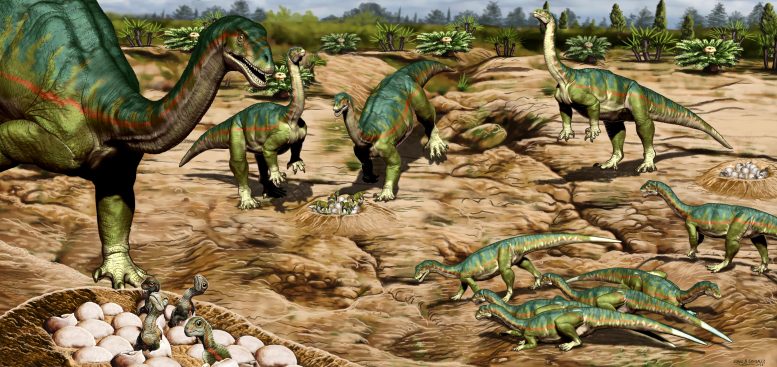
New research on a vast fossil site in Patagonia shows that some of the earliest dinosaurs, the Mussaurus patagonicus, lived in herds and suggests that this behavior may have been one of the keys to the success of dinosaurs. Credit: Jorge Gonzalez
Using X-ray tomography imaging, they were able to examine the eggs’ contents without breaking them apart, and discovered preserved embryos within, which they used to confirm that the fossils were all members of Mussaurus patagonicus — a plant-eating dinosaur that lived in the early Jurassic period and is classified as a sauropodomorph, a predecessor of the massive, long-necked sauropods that later roamed the Earth.
Surprisingly, the researchers observed that the fossils were grouped by age: Dinosaur eggs and hatchlings were found in one area, while skeletons of juveniles were grouped in a nearby location. Meanwhile, remains of adult dinosaurs were found alone or in pairs throughout the field site.
From CONICET Documental: “Earliest evidence of herd-living and age segregation amongst dinosaurs.”
This “age segregation,” the researchers believe, is a strong sign of a complex, herd-like social structure. The dinosaurs likely worked as a community, laying their eggs in a common nesting ground. Juveniles congregated in “schools,” while adults roamed and foraged for the herd.
“This may mean that the young were not following their parents in a small family structure,” says team member Jahandar Ramezani, a research scientist in MIT’s Department of Earth, Atmospheric and Planetary Sciences. “There’s a larger community structure, where adults shared and took part in raising the whole community.”
Ramezani dated ancient sediments among the fossils and determined that the dinosaur herd dates back to around 193 million years ago, during the early Jurassic period. The team’s results represent the earliest evidence of social herding among dinosaurs.
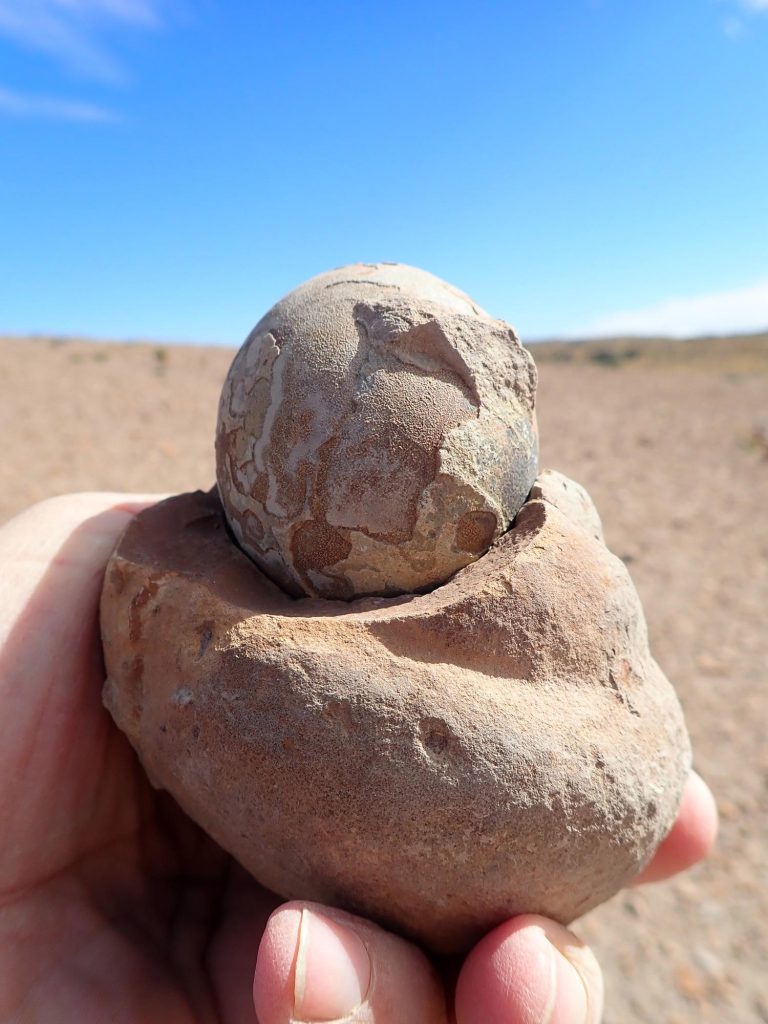
Paleontologists in Argentina unearthed a community of dinosaurs in Patagonia, including a nest of chicken-sized eggs, such as the one shown here. Credit: Roger Smith
Living in herds may have given Mussaurus and other social sauropodomorphs an evolutionary advantage. These early dinosaurs originated in the late Triassic, shortly before an extinction event wiped out many other animals. For whatever reason, sauropodomorphs held on and eventually dominated the terrestrial ecosystem in the early Jurassic.
“We’ve now observed and documented this earliest social behavior in dinosaurs,” Ramezani says. “This raises the question now of whether living in a herd may have had a major role in dinosaurs’ early evolutionary success. This gives us some clues to how dinosaurs evolved.”
Early herding
Since 2013, paleontologists on the team have worked in the Laguna Colorada Formation, a site in southern Patagonia that is known for bearing fossils of early sauropodomorphs. When scientists first discovered fossils within this formation in the 1970s, they named them Mussaurus for “mouse lizard,” as they assumed the skeletons were of miniature dinosaurs.
Only much later did scientists, including members of the Argentinian team, discover bigger skeletons, indicating Mussaurus adults were much larger than their rodent namesakes. The name stuck, however, and the team has continued to unearth a rich collection of Mussaurus fossils from a small, square kilometer of the formation.
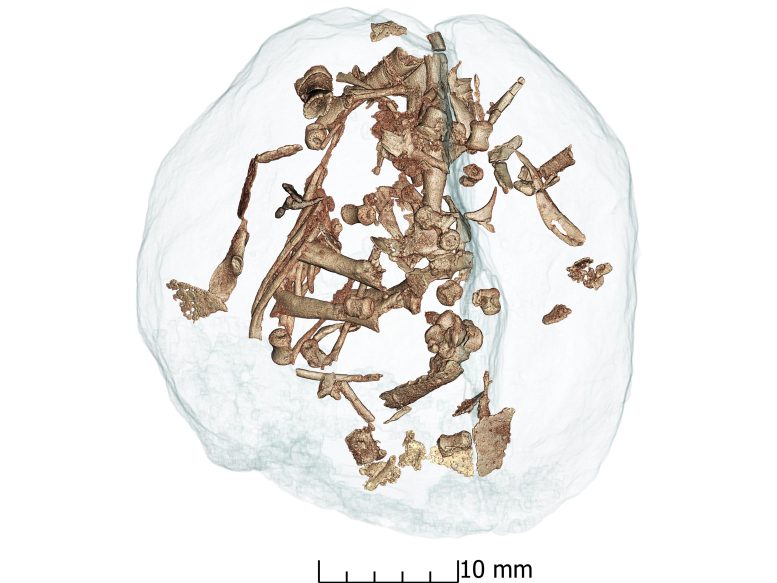
Using X-ray imaging, the scientists scanned eggs to discover preserved embryo skeletons, which they used to confirm the fossils as members of the plant-eating dinosaur, Mussaurus patagonicus. Credit: Vincent Fernandez
The fossils they have identified so far were found in three sedimentary layers spaced close together, indicating that the region may have been a common breeding ground where the dinosaurs returned regularly, perhaps to take advantage of favorable seasonal conditions.
Among the fossils they uncovered, the team discovered a group of 11 articulated juvenile skeletons, intertwined and overlapping each other, as if they had been suddenly thrown together. In fact, judging from the remarkably preserved nature of the entire collection, the team believes this particular herd of Mussaurus died “synchronously,” perhaps quickly buried by sediments.
Based on evidence of ancient flora in the nearby outcrops, the Laguna Colorada Formation has long been assumed to be relatively old on the dinosaur timescale. The team wondered: Could these dinosaurs have been herding from early on?
“People already knew that in the late Jurassic and Cretaceous, the large herbivore dinosaurs exhibited social behavior — they lived in herds and had nesting spots,” Ramezani says. “But the question has always been, when was the earliest time for such herding behavior?”
A gregarious line
To find out, Diego Pol, a paleontologist at the Egidio Feruglio Paleontological Museum in Argentina who led the study, looked for samples of volcanic ash among the fossils to send to Ramezani’s lab at MIT. Volcanic ash can contain zircon — mineral grains containing uranium and lead, the isotopic ratios of which Ramezani can precisely measure. Based on uranium’s half-life, or the time it takes for half of the element to decay into lead, he can calculate the age of the zircon and the ash in which it was found. Ramezani successfully identified zircons in two ash samples, all of which he dated to around 193 million years old.
Since the volcanic ash was found in the same sediment layers as the fossils, Ramezani’s analyses strongly suggest that the dinosaurs were buried at the same time the ash was deposited. A likely scenario may have involved drought and wind-blown dust that starved and rapidly buried the herd, while ash from a distant eruption happened to drift over and, luckily for science, deposit zircons in the sediments.
The team of scientists used high-energy X-rays at the European Synchrotron (ESRF) to penetrate the dinosaur eggs without destroying them and get a full view inside them. Credit: Vincent Fernandez/Diego Pol/ESRF
Taken together, the team’s results show that Mussaurus and possibly other dinosaurs evolved to live in complex social herds as early as 193 million years ago, around the dawn of the Jurassic period.
“Evidence suggests that Mussaurus optimized foraging potentials during the early Jurassic via age-based social partitioning — neonates, juveniles, and adults apparently foraged, and perished, in age-based groups,” says Raymond Rogers, a professor of geology at Macalester College, who was not involved in the study. “This type of gregarious behavior is common today in large terrestrial herbivores. It is amazing to see clear evidence of the same phenomenon in this early dinosaur species.”
Scientists suspect that two other types of early dinosaurs — Massospondylus from South Africa and Lufengosaurus from China — also lived in herds around the same time, although the dating for these dinosaurs has been less precise. If multiple separate lines of dinosaurs lived in herds, the researchers believe the social behavior may have evolved earlier, perhaps as far back as their common ancestor, in the late Triassic.
“Now we know herding was going on 193 million years ago,” Ramezani says. “This is the earliest confirmed evidence of gregarious behavior in dinosaurs. But paleontological understanding says, if you find social behavior in this type of dinosaur at this time, it must have originated earlier.”
Reference: “Earliest evidence of herd-living and age segregation amongst dinosaurs” by Diego Pol, Adriana C. Mancuso, Roger M. H. Smith, Claudia A. Marsicano, Jahandar Ramezani, Ignacio A. Cerda, Alejandro Otero and Vincent Fernandez, 21 October 2021, Scientific Reports.
DOI: 10.1038/s41598-021-99176-1
This research was supported, in part, by National Science Foundation in the U.S. and the National Scientific and Technical Research Council of Argentina.

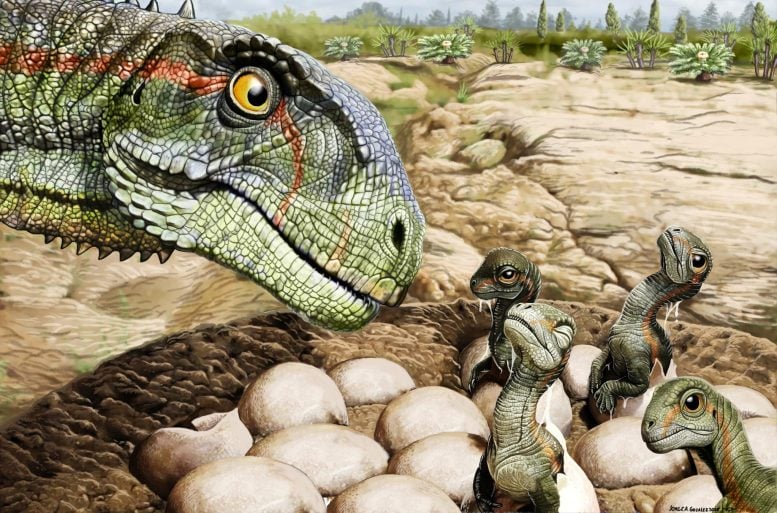

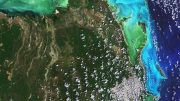

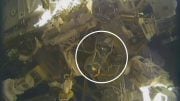
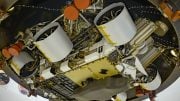

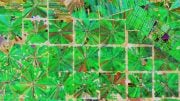

Old News shines like an old pair of pants. Fossils from the Colorado “Hogback” formation (and elsewhere) told the tale 30+years ago. Next someone will DISCOVER that the Earth isn’t FLAT.
“[T]he team believes this particular herd of Mussaurus died ‘synchronously,’ perhaps quickly buried by sediments.”
Wow, what a concept. In fact, fossils don’t even form (ignoring specimens trapped in amber or ice, which is not fossilization) except under these conditions. Fossil beds around the world attest to this.
pre event
possible one of four events that may have caused
may have perhaps died synchronously perhaps quickly buried by sediments
13,499,000,000 anno universo = 201,000,000 annual years ago the late triassic event caused by another large scale eruption this time in the central atlantic magmatic province camp which heralded the splitting of the supercontinent pangaea and the initial opening of what would later become the atlantic large igneous province lip
201,000,000 mass extinction three out of four species disappeared release of co2 by volcanism into atmosphere but also and mercury poison toxins released into sediments causing destruction and devastation wreaking havoc possibly 95% of species life on earth disappeared
Lips may be responsible for 5 of major extinction events during last 500,000,000 years
Triassic Jurassic argentina to Greenland Nevada to Austria mercury level spike concentrations
Fern spores in sediments mutation from increased levels of mercury
Food chain negative reaction effect
pre event
possible two of four events that may have caused
may have perhaps died synchronously perhaps quickly buried by sediments
200,000,000
the earths interior is a mystery at greater depths of 660 kilometres
plates and plumes produce a coherent tomograghic signal in s wave models
c west of equator 0 subducting plate at 2000 kilometres depth
32m 0 equator west coast of africa gabon subducting plate 2000 kilometres
subducting record on somalia 2000 kilometre depth = 4000 kilometres from earth core
subducting record gabon and somalia 2500 kilometre depth = 3500 kilometres from earth core
was west africa connected to south america at this time period 200,000,000 years ago
pre event
possible three of four events that may have caused
may have perhaps died synchronously perhaps quickly buried by sediments
13,500,000,000 anno universo = 200,000,000 annual years ago approximately portugal guarda unconfirmed 30 kilometre impact crater dent in the ground 40 38 n 7 06 w
gondwanaland south america attached to south africa india pre collision australis antarctica
africa was at the middle of the world the centre of the world of pangaea before it now starts to break up and avalonia southern eire is attached to laurentia canada and usa with europe lingering somewhere near by
jurassic period immense dinosaurs gigantism is an evolutionary survival strategy especially for herbivores animals because size is a form of defense against predators
eleventh recorded senior mass extenction event mee0011 200,000,000 4 0f 5 senior
pre event
possible four of four events that may have caused
may have perhaps died synchronously perhaps quickly buried by sediments
196,000,000c annual year ago sun enters milky way galactic disc topside
post event
possible five of four events that may have caused
may have perhaps died synchronously perhaps quickly buried by sediments
13,510,000,000 anno universo = 190,000,000 annual years ago
marion hotspot below south Africa in ocean = karru flood basalts on surface of south Africa amd Madagascar island
Complex social herd behavior so unique in dinosaur no reptile does that only bird mammal does that .i guest they do not watch Youtube they are two report of modern crocodilian does that/video/ gharial common caiman because they are dinosaur the last living dinosaur the most advance dinosaur ever they are so advance they replace rest of the dinosaur .spinosauridae is the king of the dinosaur. They are 2 sauropod one is a fake both are dinosaur but they are not closely related. one have bird skull other have tetanuran wider skull the same claim about ceratosaurus is a tetanuran a prototetanuran but wider skull was before ceratosaurus .protosuchus type was before. all thou skull is wider than normal 4 finger dinosaur but it is a 4 finger dinosaur skull not a tetanuran skull .t.rex modern crocodilian have wider tetanuran skull they have lot of hole in the skull that match mammal. The 2 sauropod is convergent evolution only the one with a bird skull is a true sauropod .allso both were extremely aquatic smooth skin gator tail skin no osteoderm but one of them later become extremely land base with heavy armor skin giant osteoderm .i think wider sauropod skull is related to protosuchus type with smooth skin clearly these are very aquatic they have gator ankle they turn into gator ankle .it is supported by whale nose.